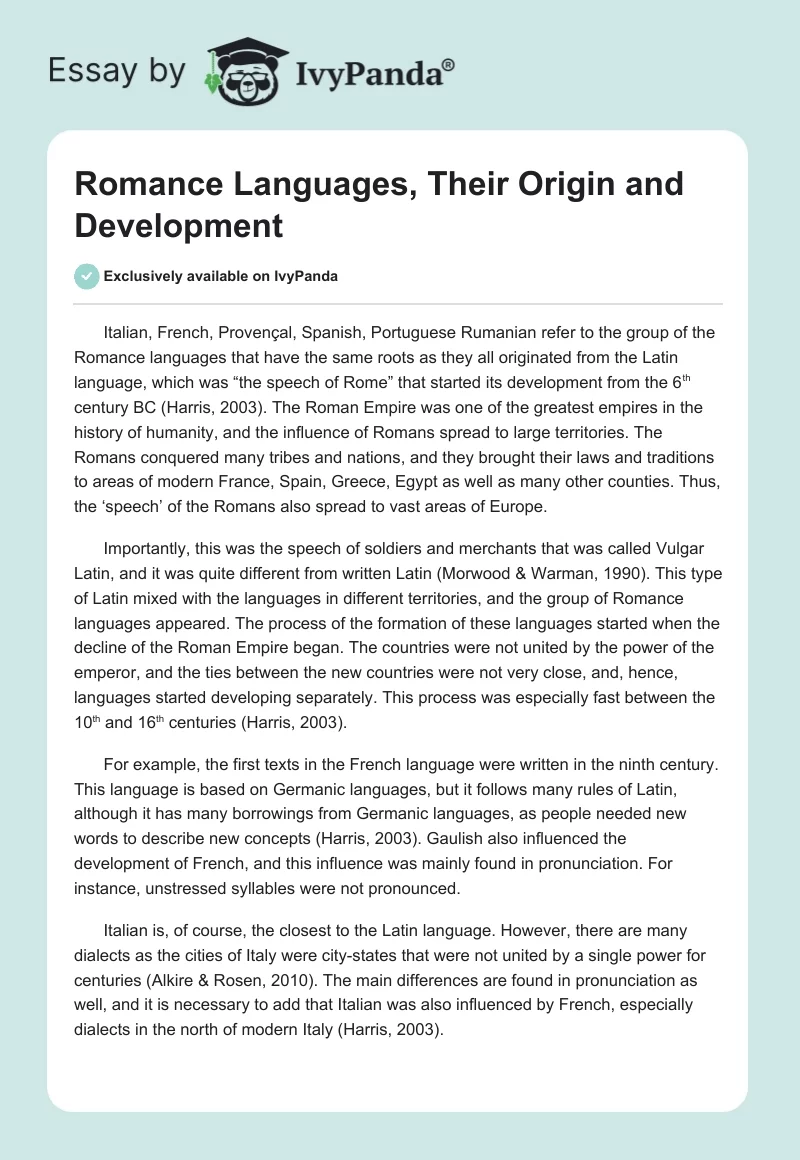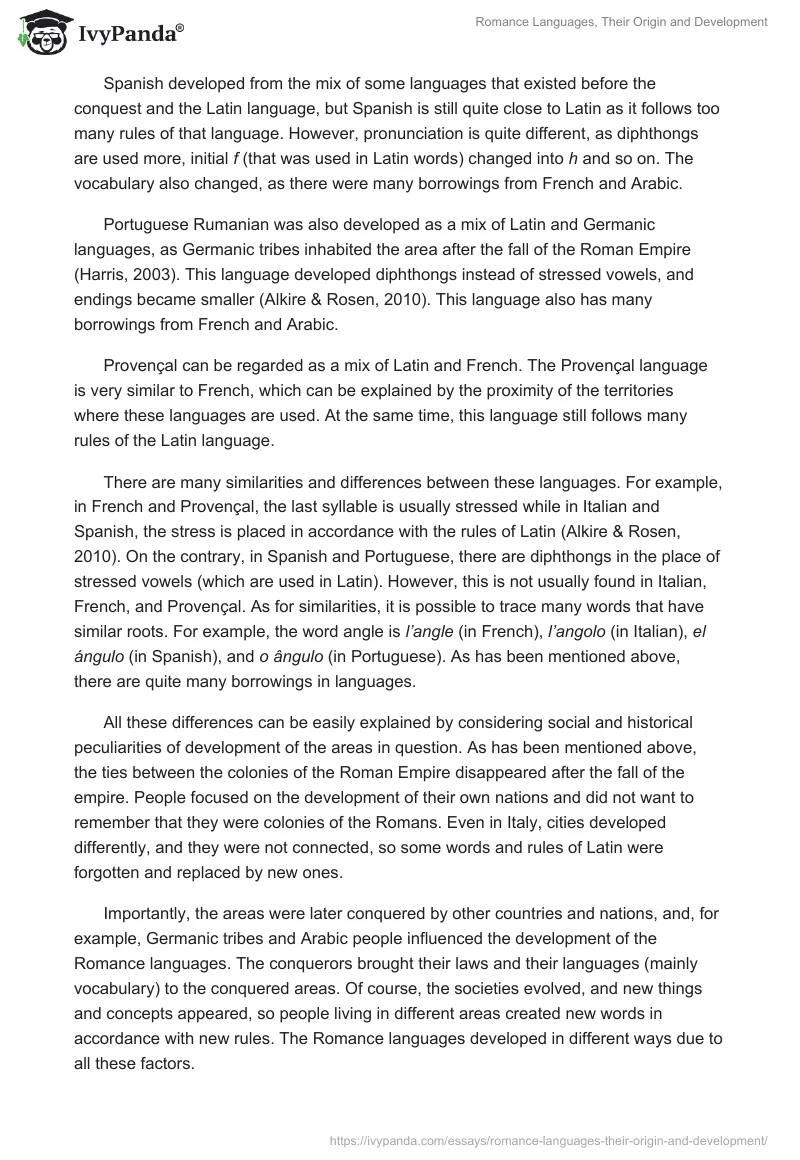Italian, French, Provençal, Spanish, Portuguese Rumanian refer to the group of the Romance languages that have the same roots as they all originated from the Latin language, which was “the speech of Rome” that started its development from the 6th century BC (Harris, 2003). The Roman Empire was one of the greatest empires in the history of humanity, and the influence of Romans spread to large territories. The Romans conquered many tribes and nations, and they brought their laws and traditions to areas of modern France, Spain, Greece, Egypt as well as many other counties. Thus, the ‘speech’ of the Romans also spread to vast areas of Europe.
Importantly, this was the speech of soldiers and merchants that was called Vulgar Latin, and it was quite different from written Latin (Morwood & Warman, 1990). This type of Latin mixed with the languages in different territories, and the group of Romance languages appeared. The process of the formation of these languages started when the decline of the Roman Empire began. The countries were not united by the power of the emperor, and the ties between the new countries were not very close, and, hence, languages started developing separately. This process was especially fast between the 10th and 16th centuries (Harris, 2003).
For example, the first texts in the French language were written in the ninth century. This language is based on Germanic languages, but it follows many rules of Latin, although it has many borrowings from Germanic languages, as people needed new words to describe new concepts (Harris, 2003). Gaulish also influenced the development of French, and this influence was mainly found in pronunciation. For instance, unstressed syllables were not pronounced.
Italian is, of course, the closest to the Latin language. However, there are many dialects as the cities of Italy were city-states that were not united by a single power for centuries (Alkire & Rosen, 2010). The main differences are found in pronunciation as well, and it is necessary to add that Italian was also influenced by French, especially dialects in the north of modern Italy (Harris, 2003).
Spanish developed from the mix of some languages that existed before the conquest and the Latin language, but Spanish is still quite close to Latin as it follows too many rules of that language. However, pronunciation is quite different, as diphthongs are used more, initial f (that was used in Latin words) changed into h and so on. The vocabulary also changed, as there were many borrowings from French and Arabic.
Portuguese Rumanian was also developed as a mix of Latin and Germanic languages, as Germanic tribes inhabited the area after the fall of the Roman Empire (Harris, 2003). This language developed diphthongs instead of stressed vowels, and endings became smaller (Alkire & Rosen, 2010). This language also has many borrowings from French and Arabic.
Provençal can be regarded as a mix of Latin and French. The Provençal language is very similar to French, which can be explained by the proximity of the territories where these languages are used. At the same time, this language still follows many rules of the Latin language.
There are many similarities and differences between these languages. For example, in French and Provençal, the last syllable is usually stressed while in Italian and Spanish, the stress is placed in accordance with the rules of Latin (Alkire & Rosen, 2010). On the contrary, in Spanish and Portuguese, there are diphthongs in the place of stressed vowels (which are used in Latin). However, this is not usually found in Italian, French, and Provençal. As for similarities, it is possible to trace many words that have similar roots. For example, the word angle is l’angle (in French), l’angolo (in Italian), el ángulo (in Spanish), and o ângulo (in Portuguese). As has been mentioned above, there are quite many borrowings in languages.
All these differences can be easily explained by considering social and historical peculiarities of development of the areas in question. As has been mentioned above, the ties between the colonies of the Roman Empire disappeared after the fall of the empire. People focused on the development of their own nations and did not want to remember that they were colonies of the Romans. Even in Italy, cities developed differently, and they were not connected, so some words and rules of Latin were forgotten and replaced by new ones.
Importantly, the areas were later conquered by other countries and nations, and, for example, Germanic tribes and Arabic people influenced the development of the Romance languages. The conquerors brought their laws and their languages (mainly vocabulary) to the conquered areas. Of course, the societies evolved, and new things and concepts appeared, so people living in different areas created new words in accordance with new rules. The Romance languages developed in different ways due to all these factors.
In conclusion, it is possible to state that the Romance languages have the same root, but they developed quite differently. The Roman Empire occupied a great territory where Latin was used as an international language, but the fall of the empire led to the development of new countries and new languages. The major reason for the differences in Romance languages is that the newly developed countries interacted with different countries and nations, and new words and linguistic rules appeared and replaced old Latin forms and words.
Reference List
Alkire, T., & Rosen, C. (2010). Romance languages: A historical introduction. New York, NY: Cambridge University Press.
Harris, M. (2003). The Romance languages. In M. Harris & N. Vincent (Eds.), The Romance languages (pp. 1-26). New York, NY: Oxford University Press.
Morwood, J., & Warman, M. (1990). Our Greek and Latin roots. New York, NY: Cambridge University Press.


